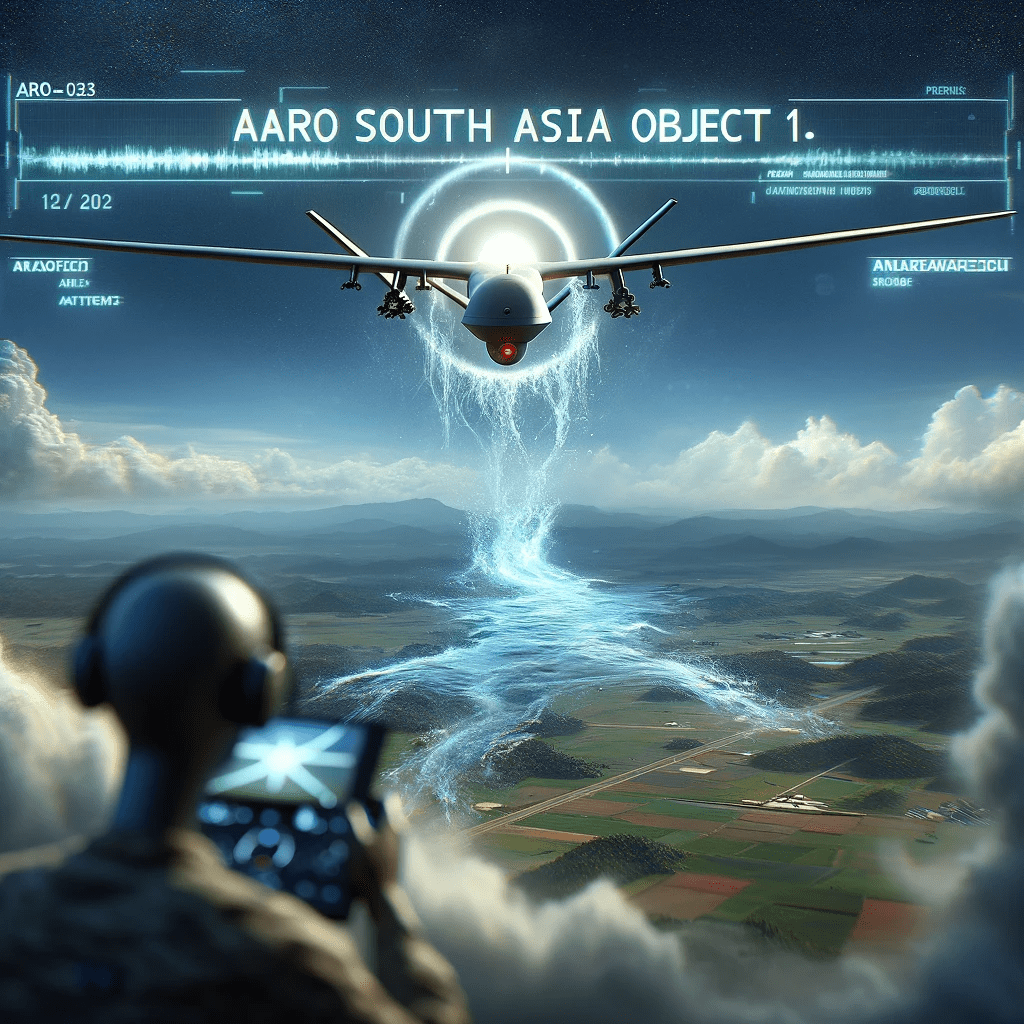AARO South Asia Object 1: MQ-9 UAP Incident (2023)

During a public hearing concerning Unidentified Anomalous Phenomena, held by the Senate Armed Services Committee on April 19, Dr. Sean Kirkpatrick, who serves as the director of the All-domain Anomaly Resolution Office (AARO), presented a video. This video displayed an unknown object moving across the frame, leaving behind what seemed to be an atmospheric disturbance or a water-like trail, known as cavitation, as it traversed the sensor’s field of view from one side to the other.
The video was captured in South Asia by an advanced MQ-9 drone equipped with a forward-looking infrared video sensor. Interestingly, the MQ-9 drone that captured the footage was originally focused on recording another MQ-9 drone in the area.
To thoroughly understand the nature of the unidentified object, the AARO team performed a detailed analysis. This investigation involved studying the original full-motion video, incorporating additional footage captured with a lens that had a longer focal length, and cross-referencing commercial flight data in that specific geographic region.
Based on their comprehensive assessment, AARO has come to the preliminary conclusion that the mysterious object is most likely a commercial aircraft. Additionally, they determined that the trailing cavitation effect visible in the video is probably not an actual physical phenomenon but rather a digital artifact resulting from video compression techniques used in the sensor system. The final determination regarding this case is still under review.
The information listed on the video provides specific details that can be crucial for understanding the context of the footage. Here’s how to interpret each component:
- Mission Report: 8339574 – This likely refers to a unique identifier or a code number assigned to the mission during which the footage was captured. This code allows analysts, investigators, or anyone else reviewing the footage to cross-reference it with a detailed mission report. This report would contain various other pieces of information, such as the objectives of the mission, the personnel involved, and any significant events or findings.
- January 15, 2023 – This is the date the footage was taken. The date can be crucial for several reasons, such as matching the video with other data sources like satellite imagery or commercial flight data. It also provides context, allowing investigators to look at what else might have been happening in the region at that time, which could offer explanations or raise further questions.
- 1251Z – This is the time the footage was captured, given in Coordinated Universal Time (UTC), often referred to as Zulu time in military contexts (hence the ‘Z’). The precise timing can be essential for time-sensitive analysis, such as calculating the speed of the object based on its appearance in multiple frames or matching the event with radar or other sensor data recorded at the same time.
So, in summary, the footage is from a mission identified by the report number 8339574, was captured on January 15, 2023, and the specific time of recording was at 12:51 UTC. This information would be vital for any subsequent analysis or investigation of the footage.
The likelihood of U.S. military operations taking place in any of these South Asian countries would depend on a range of factors including geopolitical considerations, historical precedents, and current alliances. Here is a general assessment:
- Afghanistan: This country has seen extensive U.S. military operations since 2001, although U.S. troops were officially withdrawn in August 2021. Given the history and the ongoing concerns about terrorism, it is plausible that the U.S. could be involved in some form of military operation here in the future, although the political climate for such involvement is very uncertain.
- Bangladesh: The likelihood is relatively low. While the U.S. and Bangladesh have cooperated on various issues, including counter-terrorism, there hasn’t been a significant U.S. military operation in the country.
- Bhutan: Extremely unlikely. Bhutan maintains a policy of neutrality and has no diplomatic relations with the U.S. It is also closely aligned with India, which generally opposes external military involvement in the region.
- India: Very unlikely. India is a major regional power with its own strong military capabilities. While the U.S. and India have been strengthening their strategic partnership, this has not included U.S. military operations on Indian soil.
- Maldives: Unlikely, although the Maldives has strategic importance given its location in the Indian Ocean. The country has generally enjoyed a peaceful status and has not been a location for U.S. military operations.
- Nepal: Very unlikely. Nepal is a non-aligned country with a strong tradition of independence, and there is no precedent for U.S. military operations there.
- Pakistan: Complicated. While Pakistan has been an ally of the U.S. in the past, especially during the Cold War and the post-9/11 period, relations have been strained due to issues like terrorism and Pakistan’s relationship with China. U.S. military operations have taken place in Pakistan (e.g., the raid that killed Osama bin Laden), but such operations are highly sensitive and fraught with geopolitical implications.
- Sri Lanka: Unlikely. Sri Lanka has its own complicated internal dynamics and has not been a location for U.S. military operations.
In summary, based on historical precedent and geopolitical considerations, Afghanistan and Pakistan would be the most likely candidates for U.S. military operations in South Asia and likely the location of this video.

